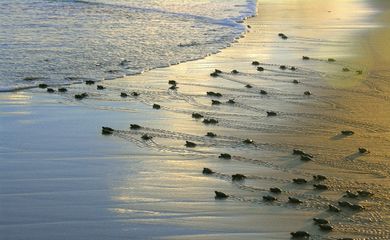Brazilian initiative protects 40 million sea turtles


In sea turtles’ next spawning season on the Brazilian coast, bathed by the Atlantic Ocean, the Tamar environmental protection project is likely to reach the threshold of 40 million protected animals over the course of nearly four decades of work.

“These are turtles on a transcontinental trip to Brazilian beaches. It’s important to remember, of every thousand turtles that are born, only one or two survive. There’s still a lot to be done to rid these animals of the threat of extinction,” said biologist Guy Marcovaldi, founder of the project.
Turtles have a long life cycle and take 20 to 30 years to breed. In each season, some 2 million young are born on Brazilian beaches and monitored by Tamar, which also works in the protection of young and adult turtles rescued from bycatch. Accidents with nets and fishing hooks, pieces of plastic and vehicles trafficking on the beach pose risks to the animals.
About Tamar
The Tamar Project was created in 1980 and is internationally hailed as one of the world’s most successful experiences in sea conservation. A role model for initiatives in both Brazil and other countries, especially because it directly involves coastal communities in its social and environmental scope, Tamar has been backed by the Pró-Tamar Foundation since 1988 for conservation efforts and research.
Tamar was coined with the first syllables of “tartaruga marinha,” Portuguese for sea turtle. Tamar has come to be used in reference to the Program for the Conservation of Sea Turtles in Brazil.
Protected species
In a partnership with the Chico Mendes Biodiversity Conservation Institute (ICMBio), of the Brazilian government, the Tamar Project contributes to the restoration of four sea turtle species: the olive ridley sea turtle, the hawksbill sea turtle, the loggerhead sea turtle, and the leatherback sea turtle.
The work of Tamar also ensures the stability of the green sea turtle. The mission of the project includes research, conservation, and the handling of the five species, all of which threatened with extinction.
The initiative covers approximately 1.1 thousand kilometers of beaches along the Brazilian coast, in areas that serve for sea turtles to feed, breed, grow, and rest. The protection area encompasses parts of the coast and oceanic islands in the states of Bahia, Sergipe, Pernambuco, Rio Grande do Norte, Ceará, Espírito Santo, Rio de Janeiro, São Paulo, and Santa Catarina.
Tamar is part of the Network of Projects for Sea Biodiversity—dubbed Rede Biomar in Portuguese—which also comprises projects to protect the albatross, the humpback whale, corals, and the spinner dolphin. These initiatives are sponsored by the social and environmental program of Brazil’s state-controlled oil giant Petrobras.




